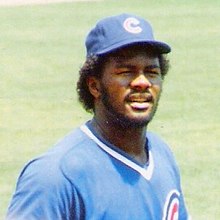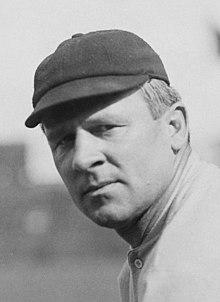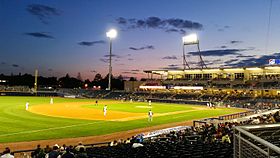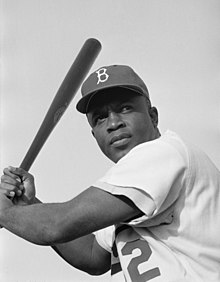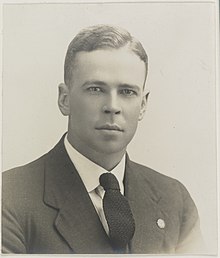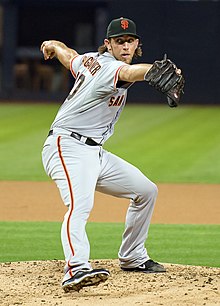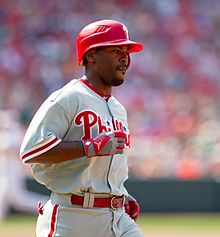Portal:Baseball
Portal maintenance status: (June 2018)
|
| Main page | Content, Categories & Topics | WikiProjects & Things you can do |
The Baseball Portal
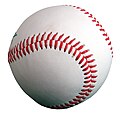
Baseball is a bat-and-ball sport played between two teams of nine players each, taking turns batting and fielding. The game occurs over the course of several plays, with each play generally beginning when a player on the fielding team, called the pitcher, throws a ball that a player on the batting team, called the batter, tries to hit with a bat. The objective of the offensive team (batting team) is to hit the ball into the field of play, away from the other team's players, allowing its players to run the bases, having them advance counter-clockwise around four bases to score what are called "runs". The objective of the defensive team (referred to as the fielding team) is to prevent batters from becoming runners, and to prevent runners' advance around the bases. A run is scored when a runner legally advances around the bases in order and touches home plate (the place where the player started as a batter).
The opposing teams switch back and forth between batting and fielding; the batting team's turn to bat is over once the fielding team records three outs. One turn batting for each team constitutes an inning. A game is usually composed of nine innings, and the team with the greater number of runs at the end of the game wins. Most games end after the ninth inning, but if scores are tied at that point, extra innings are usually played. Baseball has no game clock, though some competitions feature pace-of-play regulations such as the pitch clock to shorten game time.
Baseball evolved from older bat-and-ball games already being played in England by the mid-18th century. This game was brought by immigrants to North America, where the modern version developed. Baseball's American origins, as well as its reputation as a source of escapism during troubled points in American history such as the American Civil War and the Great Depression, have led the sport to receive the moniker of "America's Pastime"; since the late 19th century, it has been unofficially recognized as the national sport of the United States, though in modern times is considered less popular than other sports, such as American football. In addition to North America, baseball spread throughout the rest of the Americas and the Asia–Pacific in the 19th and 20th centuries, and is now considered the most popular sport in parts of Central and South America, the Caribbean, and East Asia, particularly in Japan, South Korea, and Taiwan. (Full article...)
 Featured articles - load new batch
Featured articles - load new batch
-
Image 1
Lee Arthur Smith (born December 4, 1957) is an American former professional baseball pitcher who played 18 years in Major League Baseball (MLB) for eight teams. Serving mostly as a relief pitcher during his career, he was a dominant closer, was the first pitcher to reach 400 saves, and held the major league record for career saves from 1993 until 2006, when Trevor Hoffman passed his total of 478. He was elected to the National Baseball Hall of Fame as part of the class of 2019 by the Today's Game Era Committee.
A native of Jamestown in Bienville Parish in north Louisiana, Smith was scouted by Buck O'Neil and was selected by the Chicago Cubs in the 1975 MLB draft. Smith was an intimidating figure on the pitcher's mound at 6 feet 6 inches (1.98 m) and 265 pounds (120 kg) with a 95-mile-per-hour (150 km/h) fastball. In 1991, he set a National League (NL) record with 47 saves for the St. Louis Cardinals, and was runner-up for the league's Cy Young Award; it was the second of three times Smith led the NL in saves, and he later led the American League (AL) in saves once. When he retired, he held the major league record for career games finished (802) and was third in games pitched (1,022). He holds the Cubs' team record for career saves (180), and held the same record for the Cardinals (160) until 2006. (Full article...) -
Image 2Advertisement in Billboard magazine in 1907
How Brown Saw the Baseball Game is an American short silent comedy film produced in 1907 and distributed by the Lubin Manufacturing Company. The film follows a baseball fan named Mr. Brown who overdrinks before a baseball game and becomes so intoxicated that the game appears to him in reverse motion. During production, trick photography was used to achieve this effect. The film was released in November 1907. It received a positive review in a 1908 issue of The Courier-Journal that reported the film was successful and "truly funny". As of 2021[update], it is unclear whether the print of the film has survived. The identities of the film cast and production crew are unknown. Film historians have noted similarities between the plot of How Brown Saw the Baseball Game and How the Office Boy Saw the Ball Game. It is a comedy film directed by Edwin S. Porter, having released a year before How Brown Saw the Baseball Game. (Full article...) -
Image 3
Daniel Lucius "Doc" Adams (November 1, 1814 – January 3, 1899) was an American baseball player and executive who is regarded by historians as an important figure in the sport's early years. For most of his career he was a member of the New York Knickerbockers. He first played for the New York Base Ball Club in 1840 and started his Knickerbockers career five years later, continuing to play for the club into his forties and to take part in inter-squad practice games and matches against opposing teams. Researchers have called Adams the creator of the shortstop position, which he used to field short throws from outfielders. In addition to his playing career, Adams manufactured baseballs and oversaw bat production; he also occasionally acted as an umpire.
From 1847 to 1861, the Knickerbockers selected Adams as their president six times, and as a vice president, treasurer, or director in six other years. As president of the club, Adams was an advocate of rule changes in baseball that resulted in nine-man teams and nine-inning games. When the National Association of Base Ball Players (NABBP) was formed in 1858, he led the rules and regulations committee of the new organization. In his role, Adams ruled that the fields' bases should be 90 feet (27 m) apart, the modern distance, and supported the elimination of the "bound rule", which allowed for balls caught after one bounce to be recorded as outs. He resigned from his positions with the Knickerbockers and NABBP in 1862. Adams' contributions in creating baseball's rules went largely unrecognized for decades after his 1899 death, but in 1980 a letter about him appeared in The New York Times; by 1993, researcher John Thorn had written about Adams' role. Other historians have given him credit for helping to develop the sport, and Thorn has called Adams "first among the Fathers of Baseball". (Full article...) -
Image 4
John Joseph McGraw (April 7, 1873 – February 25, 1934) was an American Major League Baseball (MLB) player and manager who was for almost thirty years manager of the New York Giants. He was also the third baseman of the pennant-winning 1890s Baltimore Orioles teams, noted for their innovative, aggressive play.
McGraw was born into poverty in Truxton, New York. He found an escape from his hometown and a bad family situation through baseball, beginning a quick rise through the minor leagues that led him to the Orioles at the age of 18. Under the tutelage of manager Ned Hanlon, the Orioles of the 1890s won three National League (NL) pennants; McGraw was one of the stalwarts of the team alongside Wee Willie Keeler, Hughie Jennings, and Wilbert Robinson. The Orioles perfected the hit and run play and popularized the Baltimore chop; they also sought to win by intimidating the opposing team and the umpire. (Full article...) -
Image 5
First Horizon Park, formerly known as First Tennessee Park, is a baseball park in downtown Nashville, Tennessee, United States. The home of the Triple-A Nashville Sounds of the International League, it opened on April 17, 2015, and can seat up to 10,000 people. It replaced the Sounds' former home, Herschel Greer Stadium, where the team played from its founding in 1978 through 2014.
The park was built on the site of the former Sulphur Dell, a minor league ballpark in use from 1885 to 1963. It is located between Third and Fifth Avenues on the east and west (home plate, the pitcher's mound, and second base are directly in line with Fourth Avenue to the stadium's north and south) and between Junior Gilliam Way and Harrison Street on the north and south. The Nashville skyline can be seen from the stadium to the south. (Full article...) -
Image 6
James Howard Thome (/ˈtoʊmi/; TOH-mee; born August 27, 1970) is an American former professional baseball corner infielder and designated hitter, who played in Major League Baseball (MLB) for 22 seasons (1991–2012). A prolific power hitter, Thome hit 612 home runs during his career—the eighth-most all time. He amassed a total of 2,328 hits and 1,699 runs batted in (RBIs). His career batting average was .276. He was a member of five All-Star teams and won a Silver Slugger Award in 1996.
Thome grew up in Peoria, Illinois, as part of a large blue-collar family of athletes, who predominantly played baseball and basketball. After attending Illinois Central College, he was drafted by the Indians in the 1989 draft, and made his big league debut in 1991. Early in his career, Thome played third base, before eventually becoming a first baseman. With the Indians, he was part of a core of players that led the franchise to five consecutive playoff appearances in the 1990s, including World Series appearances in 1995 and 1997. Thome spent over a decade with Cleveland, before leaving via free agency after the 2002 season, to join the Philadelphia Phillies, with whom he spent the following three seasons. Traded to the Chicago White Sox before the 2006 season, he won the American League (AL) Comeback Player of the Year Award that year and joined the 500 home run club during his three-season tenure with the White Sox. By this point in his career, back pain limited Thome to being a designated hitter. After stints with the Los Angeles Dodgers and Minnesota Twins, he made brief returns to Cleveland and Philadelphia, before ending his career with the Baltimore Orioles. Upon retiring, Thome accepted an executive position with the White Sox. (Full article...) -
Image 7

Depiction of the game from The Boston Globe
On Saturday, May 1, 1920, the Brooklyn Dodgers and the Boston Braves played to a 1–1 tie in 26 innings, the most innings ever played in a single game in the history of Major League Baseball (MLB). The game was played at Braves Field in Boston before a crowd estimated at 4,000. Both Leon Cadore of Brooklyn and Joe Oeschger of Boston pitched complete games, and with 26 innings pitched, jointly hold the record for the longest pitching appearance in MLB history. Their record is considered unbreakable, as modern pitchers rarely pitch even nine innings, and newer baseball rules have made long extra-innings games a rarity.
The day of the game saw rainy weather, and it was uncertain if the game would be played, but the skies cleared enough to allow it to proceed. Brooklyn scored a run in the fifth inning, and Boston in the sixth; thereafter, the pitchers became increasingly dominant. As the game exceeded eighteen innings, the small crowd at Braves Field cheered both pitchers. The last twenty innings were scoreless, and when darkness started to fall, the umpires called a halt after the twenty-sixth inning, as baseball fields did not yet have artificial lighting. (Full article...) -
Image 8
Michael Jeffrey Jordan (born February 17, 1963), also known by his initials MJ, is an American businessman and former professional basketball player. He played 15 seasons in the National Basketball Association (NBA) between 1984 and 2003, winning six NBA championships with the Chicago Bulls. He was integral in popularizing basketball and the NBA around the world in the 1980s and 1990s, becoming a global cultural icon. His profile on the NBA website states, "By acclamation, Michael Jordan is the greatest basketball player of all time."
Jordan played college basketball with the North Carolina Tar Heels. As a freshman, he was a member of the Tar Heels' national championship team in 1982. Jordan joined the Bulls in 1984 as the third overall draft pick and quickly emerged as a league star, entertaining crowds with his prolific scoring while gaining a reputation as one of the best defensive players. His leaping ability, demonstrated by performing slam dunks from the free-throw line in Slam Dunk Contests, earned him the nicknames "Air Jordan" and "His Airness". Jordan won his first NBA title with the Bulls in 1991 and followed that achievement with titles in 1992 and 1993, securing a three-peat. Citing "physical and mental exhaustion" from basketball and superstardom, Jordan abruptly retired from basketball before the 1993–94 NBA season to play Minor League Baseball in the Chicago White Sox organization. He returned to the Bulls in March 1995 and led them to three more championships in 1996, 1997, and 1998, as well as a then-record 72 regular season wins in the 1995–96 NBA season. Jordan retired for the second time in January 1999, returning for two more NBA seasons from 2001 to 2003 as a member of the Washington Wizards. He was selected to play for the United States national team during his college and NBA careers, winning four gold medals—at the 1983 Pan American Games, 1984 Summer Olympics, 1992 Tournament of the Americas and 1992 Summer Olympics—while also being undefeated. (Full article...) -
Image 9The Nashville Sounds Minor League Baseball team was established in Nashville, Tennessee, in 1978, after Larry Schmittou and a group of investors purchased the rights to operate an expansion franchise of the Double-A Southern League. The Sounds played their home games at Herschel Greer Stadium from its opening in 1978 until the end of the 2014 season. In 2015, the Sounds left Greer for First Tennessee Park, now known as First Horizon Park, a new facility located on the site of the historic Sulphur Dell ballpark, home to Nashville's minor league teams from 1885 to 1963.
The Sounds led all of Minor League Baseball in attendance in their inaugural season and continued to draw the Southern League's largest crowds in each of their seven years as members of the league. On the field, the team won six consecutive second-half division titles from 1979 to 1984 and won the Southern League championship twice: in 1979 as the Double-A affiliate of the Cincinnati Reds and again in 1982 as the Double-A affiliate of the New York Yankees. (Full article...) -
Image 10Adenhart pitching for the Salt Lake Bees in 2008
Nicholas James Adenhart (August 24, 1986 – April 9, 2009) was an American right-handed baseball starting pitcher who played parts of two seasons in Major League Baseball (MLB) for the Los Angeles Angels of Anaheim. In just four career games, Adenhart pitched 18 innings and posted a win-loss record of 1–0.
A graduate of Williamsport High School, Adenhart was highly touted as a high school prospect until an injury in his final game required Tommy John surgery. The Angels drafted him in the 14th round of the 2004 Major League Baseball draft, and began playing in their minor league system after the surgery was a success. He spent three full seasons in the minor leagues before making his major league debut on May 1, 2008. After appearing in three games, Adenhart spent the rest of 2008 in the minor leagues developing his skills, and in 2009 he earned a spot in the Angels' starting rotation. (Full article...) -
Image 11

Hershiser pitching for the Dodgers in 1993
During the 1988 Major League Baseball season, pitcher Orel Hershiser of the Los Angeles Dodgers set the MLB record for consecutive scoreless innings pitched. Over 59 consecutive innings, opposing hitters did not score a run against Hershiser. During the streak, he averted numerous high-risk scoring situations. The streak spanned from the sixth inning of an August 30 game against the Montreal Expos to the 10th inning of a September 28 game against the San Diego Padres. The previous record of 58+2⁄3 innings was set by former Dodger pitcher Don Drysdale in 1968; as the team's radio announcer, Drysdale called Hershiser's streak as he pursued the new record. Pundits have described the streak as among the greatest records in baseball history, with one pundit ranking it among the greatest individual feats in American sports.
During the streak, the Elias Sports Bureau changed its criteria for the official consecutive scoreless innings record for starting pitchers from including fractional innings in which one or two outs had been recorded to counting only complete scoreless innings. Since the streak was active at the end of the 1988 season, it could have spanned two separate seasons. However, Hershiser yielded a run in his first inning of work in the 1989 season against the Cincinnati Reds, thus ending the streak at 59 consecutive scoreless innings pitched. The streak includes only innings pitched in the regular season, excluding eight scoreless innings Hershiser pitched to start Game 1 of the 1988 National League Championship Series on October 4 (unofficially extending his streak to 67 combined innings). Although he completed the ninth inning in each start, the streak's final game lasted 16 innings, of which he pitched only the first 10. Thus, Hershiser did not match Drysdale's record of six consecutive complete game shutouts. Like Drysdale's streak, the penultimate game of Hershiser's streak was a Dodgers–Giants game that featured a controversial umpire's ruling that saved the streak. (Full article...) -
Image 12
Morris Berg (March 2, 1902 – May 29, 1972) was an American professional baseball catcher and coach in Major League Baseball who later served as a spy for the Office of Strategic Services during World War II. He played 15 seasons in the major leagues, almost entirely for four American League teams, though he was never more than an average player and was better known for being "the brainiest guy in baseball." Casey Stengel once described Berg as "the strangest man ever to play baseball."
Berg was a graduate of Princeton University and Columbia Law School, spoke several languages, and regularly read ten newspapers a day. His reputation as an intellectual was fueled by his successful appearances as a contestant on the radio quiz show Information Please, in which he answered questions about the etymology of words and names from Greek and Latin, historical events in Europe and the Far East, and ongoing international conferences. (Full article...) -
Image 13
Jack Roosevelt Robinson (January 31, 1919 – October 24, 1972) was an American professional baseball player who became the first African-American to play in Major League Baseball (MLB) in the modern era. Robinson broke the color line when he started at first base for the Brooklyn Dodgers on April 15, 1947. The Dodgers signing Robinson heralded the end of racial segregation in professional baseball, which had relegated black players to the Negro leagues since the 1880s.
Born in Cairo, Georgia, Robinson was raised in Pasadena, California. A four-sport student athlete at Pasadena Junior College and the University of California, Los Angeles, he was better known for football than he was for baseball, becoming a star college player with the UCLA Bruins football team. Following his college career, Robinson was drafted for service during World War II but was court-martialed for refusing to sit at the back of a segregated Army bus, eventually being honorably discharged. Afterwards, he signed with the Kansas City Monarchs of the Negro leagues, where he caught the eye of Branch Rickey, general manager of the Brooklyn Dodgers, who thought he would be the perfect candidate for breaking the color line in MLB. (Full article...) -
Image 14
William Harold Ponsford MBE (19 October 1900 – 6 April 1991) was an Australian cricketer. Usually playing as an opening batsman, he formed a successful and long-lived partnership opening the batting for Victoria and Australia with Bill Woodfull, his friend and state and national captain. Ponsford is the only player to twice break the world record for the highest individual score in first-class cricket; Ponsford and Brian Lara are the only cricketers to twice score 400 runs in an innings. Ponsford holds the Australian record for a partnership in Test cricket, set in 1934 in combination with Don Bradman (451 for 2nd wicket)—the man who broke many of Ponsford's other individual records. In fact, he along with Bradman set the record for the highest partnership ever for any wicket in Test cricket history when playing on away soil (451 runs for the second wicket)
Despite being heavily built, Ponsford was quick on his feet and renowned as one of the finest ever players of spin bowling. His bat, much heavier than the norm and nicknamed "Big Bertha", allowed him to drive powerfully and he possessed a strong cut shot. However, critics questioned his ability against fast bowling, and the hostile short-pitched English bowling in the Bodyline series of 1932–33 was a contributing factor in his early retirement from cricket a year and a half later. Ponsford also represented his state and country in baseball, and credited the sport with improving his cricketing skills. (Full article...) -
Image 15

Cobb in 1913
During the 1912 baseball season, center fielder Ty Cobb of the Detroit Tigers was suspended for ten days after entering the spectator stands at New York's Hilltop Park during a game and physically assaulting Claude Lucker, a heckler. At the time, Cobb was among the biggest stars in the major leagues. American League president Ban Johnson suspended Cobb and fined him $50 ($1,600 in 2023).
Cobb had been Lucker's verbal target throughout the four-game series between the Tigers and New York Yankees. Facing a continued stream of insults and questioning about his racial ancestry, Cobb lost his temper in the fourth inning of the fourth game, on May 15, 1912. He raced into the stands, punching and kicking Lucker; Lucker had lost eight fingers in an industrial accident and could not defend himself. Cobb was ejected from the game. Johnson witnessed these events and suspended Cobb indefinitely. Since there were few protections for ballplayers at the time from insults and objects hurled by fans, many took Cobb's side, including his teammates. After defeating the Philadelphia Athletics on May 17, the Detroit players telegraphed Johnson that they would not play again until Cobb was reinstated; Johnson refused to do so. (Full article...)
General images - load new batch
-
Image 1The typical motion of a right-handed pitcher (from Baseball rules)
-
Image 2In May 2010, the Philadelphia Phillies' Roy Halladay pitched the 20th major league perfect game. That October, he pitched only the second no-hitter in MLB postseason history. (from History of baseball)
-
Image 4A pitcher handing off the ball after being taken out of the game during a mound meeting. (from Baseball)
-
Image 5A well-worn baseball (from Baseball)
-
Image 6The standard fielding positions (from Baseball rules)
-
Image 7Pitchers are generally substituted during mound visits (team gatherings at the pitcher's mound). (from Baseball rules)
-
Image 8The strike zone, which determines the outcome of most pitches, varies in vertical length depending on the batter's typical height while swinging. (from Baseball rules)
-
Image 9A batter follows through after swinging at a pitched ball. (from Baseball rules)
-
Image 10Two players on the baseball team of Tokyo, Japan's Waseda University in 1921 (from Baseball)
-
Image 11Alexander Cartwright, father of modern baseball (from History of baseball)
-
Image 12A first baseman receives a pickoff throw, as the runner dives back to first base. (from Baseball)
-
Image 13A game from the Cantigas de Santa Maria, c. 1280, involving tossing a ball, hitting it with a stick and competing with others to catch it (from History of baseball)
-
Image 14Sadaharu Oh managing the Japan national team in the 2006 World Baseball Classic. Playing for the Central League's Yomiuri Giants (1959–80), Oh set the professional world record for home runs. (from Baseball)
-
Image 15A New York Yankees batter (Andruw Jones) and a Boston Red Sox catcher at Fenway Park (from Baseball)
-
Image 16Baseball games sometimes end in a walk-off home run, with the batting team usually gathering at home plate to celebrate the scoring of the winning run(s). (from Baseball rules)
-
Image 17By the 1860s Civil War, baseball (bottom) had overtaken its fellow bat-and-ball sport cricket (top) in popularity within the United States. (from History of baseball)
-
Image 18An Afghan girl playing baseball in August 2002 (from Baseball)
-
Image 21A runner sliding into home plate and scoring. (from Baseball)
-
Image 221906 World Series, infielders playing "in" for the expected bunt and the possible play at the plate with the bases loaded (from Baseball rules)
-
Image 23Pesäpallo, a Finnish variation of baseball, was invented by Lauri "Tahko" Pihkala in the 1920s, and after that, it has changed with the times and grown in popularity. Picture of Pesäpallo match in 1958 in Jyväskylä, Finland. (from Baseball)
-
Image 242013 World Baseball Classic championship match between the Dominican Republic and Puerto Rico, March 20, 2013 (from Baseball)
-
Image 26The NL champion New York Giants baseball team, 1913. Fred Merkle, sixth in line, had committed a baserunning gaffe in a crucial 1908 game that became famous as Merkle's Boner. (from History of baseball)
-
Image 27Defensive positions on a baseball field, with abbreviations and scorekeeper's position numbers (not uniform numbers) (from Baseball)
-
Image 29The strike zone determines the result of most pitches, and varies in vertical length for each batter. (from Baseball)
-
Image 30Jackie Robinson in 1945, with the era's Kansas City Royals, a barnstorming squad associated with the Negro American League's Kansas City Monarchs (from History of baseball)
-
Image 31Cy Young—the holder of many major league career marks, including wins and innings pitched, as well as losses—in 1908. MLB's annual awards for the best pitcher in each league are named for Young. (from Baseball)
-
Image 32Japanese-Americans spectating a World War II-era game while in an internment camp. America's ties to immigrants and to Japan have been deeply shaped by a shared baseball heritage. (from History of baseball)
-
Image 33Sadaharu Oh managing the Japan national team in the 2006 World Baseball Classic. Playing for the Central League's Yomiuri Giants (1959–80), Oh set the professional world record for home runs with 868. (from History of baseball)
-
Image 34Pick-off attempt on runner (in red) at first base (from Baseball rules)
-
Image 35Baserunners generally stand a short distance away from their base between pitches, preparing themselves to either go back or steal the next base. (from Baseball rules)
-
Image 37Fenway Park, home of the Boston Red Sox. The Green Monster is visible beyond the playing field on the left. (from Baseball)
-
Image 39Rickey Henderson—the major leagues' all-time leader in runs and stolen bases—stealing third base in a 1988 game (from Baseball)
-
Image 41The American Tobacco Company's line of baseball cards featured shortstop Honus Wagner of the Pittsburgh Pirates from 1909 to 1911. In 2007, the card shown here sold for $2.8 million. (from Baseball)
-
Image 42Cover of Official Base Ball Rules, 1921 edition, used by the American League and National League (from Baseball rules)
-
Image 43Jackie Robinson in 1945, with the era's Kansas City Royals, a barnstorming squad associated with the Negro American League's Kansas City Monarchs (from Baseball)
-
Image 45Diagram of a baseball field Diamond may refer to the square area defined by the four bases or to the entire playing field. The dimensions given are for professional and professional-style games. Children often play on smaller fields. (from Baseball)
 Good articles - load new batch
Good articles - load new batch
-
Image 1
Napoléon "Nap" Lajoie (/ˈlæʒəweɪ/; September 5, 1874 – February 7, 1959), also known as Larry Lajoie, was an American professional baseball second baseman who played 21 seasons in Major League Baseball (MLB). Nicknamed "the Frenchman", he represented both Philadelphia franchises and the Cleveland Naps, the latter of which he became the namesake of, and from 1905 through 1909, the player-manager.
Lajoie was signed to the Philadelphia Phillies of the National League (NL) in 1896. By the beginning of the 20th century, however, the upstart American League (AL) was looking to rival the supremacy of the NL and in 1901, Lajoie and dozens of former National League players joined the American League. National League clubs contested the legality of contracts signed by players who jumped to the other league, but eventually Lajoie was allowed to play for Connie Mack's Philadelphia Athletics. During the season, Lajoie set the all-time American League single-season mark for the highest batting average (.426). One year later, Lajoie went to the Cleveland Bronchos, where he would play until the 1915 season, when he returned to play for Mack and the Athletics. While with Cleveland, Lajoie's popularity led to locals electing to change the club's team name from Bronchos to Napoleons ("Naps" for short), which remained until after Lajoie departed Cleveland and the name was changed to Indians (the team's name until 2021). (Full article...) -
Image 2

Oscar E. "Reddy" Foster (August 1864 – December 19, 1908) was a Major League Baseball (MLB) player for the New York Giants in 1896. His only MLB appearance was on June 3 of that season. He primarily played catcher in his minor league career, which spanned 17 seasons. Foster was a manager as well. He was known for his fiery temper and his heavy drinking. Foster died on December 19, 1908, when he deliberately shot himself in the head with a shotgun. (Full article...) -
Image 3
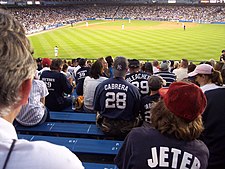
Bleachers section 39 at the old Yankee Stadium.
The Bleacher Creatures are a group of fans of the New York Yankees who are known for their strict allegiance to the team and their fierce attitude towards opposing fans and teams. The group's nickname was coined for the first time by New York Daily News columnist Filip "Flip" Bondy during the 1990s, and then he spent the 2004 season sitting with the Creatures for research on his book about the group, Bleeding Pinstripes: A Season with the Bleacher Creatures of Yankee Stadium, which was published in 2005.
A prominent aspect of the Bleacher Creatures is their use of chants and songs. The most distinguished of these is the "roll call", which is done at the beginning of every home game. Often, the opposing team's right fielder, who stands right in front of the Creatures, is a victim of their jeers and insults. For the last two decades of the original Yankee Stadium, the Creatures occupied sections 37 and 39 of the right field bleachers. In 2009, when the Yankees' new stadium was built, they were relocated and currently sit in section 203 of the right-field bleachers. Over the years, the Creatures have attracted controversy regarding their use of inappropriate chants along with their rowdiness. (Full article...) -
Image 4
Frank Daryl Tanana (born July 3, 1953) is an American former professional baseball left-handed pitcher. In a Major League Baseball career that stretched from 1973 to 1993, he pitched for the California Angels, Boston Red Sox, Texas Rangers, Detroit Tigers, New York Mets, and New York Yankees. He struck out 2,773 batters in his career and twice won playoff-clinching games for the teams he was on, the 1979 Angels and the 1987 Tigers.
Raised in northwest Detroit, Tanana was a first-round draft pick by the Angels in 1971. He made his debut with the team in 1973 and won 14 games his rookie year. Tanana and fellow starter Nolan Ryan formed one of the toughest pairs of starting pitchers to hit against in baseball. Tanana led the American League (AL) in strikeouts in 1975, then made the AL All-Star team three years in a row. He won 19 games in 1976 and led the AL with a 2.54 earned run average (ERA) in 1977. In 1979, he won the game that clinched the Angels' first-ever playoff appearance. Injuries began to take their toll on him by the end of his tenure with the Angels, and he changed his style from relying on a hard fastball to throwing a repertoire of slower pitches, using deception to get hitters out instead. (Full article...) -
Image 5
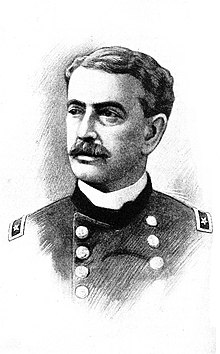
Abner Doubleday
The Doubleday myth is the claim that the sport of baseball was invented in 1839 by the future American Civil War general Abner Doubleday in Cooperstown, New York. In response to a dispute over whether baseball originated in the United States or was a variation of the British game rounders, the Mills Commission was formed in 1905 to seek out evidence. Mining engineer Abner Graves authored a letter claiming that Doubleday invented baseball. The letter was published in a newspaper and eventually used by the Mills Commission to support its finding that the game was of American origin. In 1908, it named Doubleday the creator of baseball.
The claim initially received a favorable reception from Americans, but eventually garnered criticism from various writers. Modern baseball historians generally consider the myth to be false. Graves' testimony has been critiqued in various regards, as the details of his story and his reliability as a witness have been questioned, and the Mills Commission made departures from his letter in its report. The National Baseball Hall of Fame and Museum was built in the town where Graves said the game was created, Cooperstown. The legend is well known among fans of the sport. (Full article...) -
Image 6
Madison Kyle Bumgarner (born August 1, 1989), nicknamed "MadBum", is an American professional baseball pitcher who is a free agent. Previously, he pitched in Major League Baseball (MLB) for the San Francisco Giants (2009–19) and Arizona Diamondbacks (2020–23). Bumgarner has won three World Series championships (2010, 2012, 2014) and two Silver Slugger Awards (2014, 2015). He has also been selected to four National League (NL) All-Star teams and has the most strikeouts in franchise history by a Giants left-handed pitcher.
Bumgarner played high school baseball at South Caldwell High School in Hudson, North Carolina, where he helped his team win the 2007 4A State Championship. After graduating, he was selected with the tenth overall pick in the 2007 MLB draft by the San Francisco Giants. He and Buster Posey both made their Major League debuts in 2009 and established a reputation as one of the best batteries in recent MLB history. Bumgarner pitched eight scoreless innings in Game 4 of the 2010 World Series, helping win the franchise's first World Series in San Francisco and the first since 1954. Two years later, Bumgarner pitched seven more scoreless innings in Game 2 of the 2012 World Series. In 2014, Bumgarner started the Wild Card game for the Giants, throwing a shutout against the Pittsburgh Pirates. He set the World Series record for the lowest earned run average (ERA) in 2014, with an ERA of 0.43, and took home the Most Valuable Player award as the Giants won their third World Series during his time in San Francisco. (Full article...) -
Image 7Padden in South Side Park, Chicago in 1905
Richard Joseph Padden (September 17, 1870 – October 31, 1922), nicknamed "Brains", was an American professional baseball player, born in Wheeling, West Virginia, who played mainly as a second baseman in Major League Baseball for nine seasons from 1896 to 1905.
After playing a season and a half in the minor leagues, the right-handed infielder began his major league career for the Pittsburgh Pirates. He played three seasons in Pittsburgh, from 1896 to 1898, before playing one season for the Washington Senators in 1899. He returned to the minor leagues for the 1900 season, where he was the player-manager for the Chicago White Sox, then a minor league team. When the Chicago club entered the American League, a major league, the following season, he moved on to play one season for the St. Louis Cardinals, before becoming Captain of the St. Louis Browns from 1902 and 1905. In total, Padden played in 874 games, and collected 814 hits in 3545 at bats, for a lifetime batting average of .258. He finished in the league's top-ten finishers in being hit by pitches six times, including a league-leading 18 in 1904. (Full article...) -
Image 8
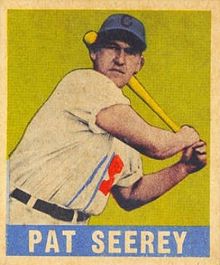
James Patrick Seerey (March 17, 1923 – April 28, 1986) was an American professional baseball player. An outfielder, Seerey played in Major League Baseball (MLB) for seven seasons in the American League with the Cleveland Indians and Chicago White Sox. In 561 career games, Seerey recorded a batting average of .224 and accumulated 86 home runs and 261 runs batted in (RBI).
Born in Oklahoma and raised in Arkansas, Seerey played football and baseball in high school. After graduating, he joined the Cleveland Indians' farm system in 1941, and made his major league debut two-and-a-half years later. He was primarily a starting outfielder the next five seasons for the Indians, but led the league in strikeouts four times. He was traded partway through the 1948 season to the Chicago White Sox, and a month after being traded became the fifth player in major league history to hit four home runs in one game. The following season, he was sent to the minor leagues, and played a few seasons in the farm system for the White Sox before retiring. (Full article...) -
Image 9
Matthew Thomas Holliday (born January 15, 1980) is an American former professional baseball left fielder. He played in Major League Baseball (MLB) from 2004 to 2018 for the Colorado Rockies, Oakland Athletics, St. Louis Cardinals, and New York Yankees. A World Series champion in 2011 with the Cardinals, Holliday played a key role in seven postseasons, including the Rockies' first-ever World Series appearance in 2007 and Cardinals' playoff success in the 2010s. His distinctions include a National League (NL) batting championship, the 2007 NL Championship Series Most Valuable Player Award (NLCS MVP), seven All-Star selections, and four Silver Slugger Awards. Other career accomplishments include 300 home runs, more than 2,000 hits, and batting over .300 eight times.
The Colorado Rockies selected Holliday in the seventh round of the 1998 MLB draft from high school in Oklahoma, where he also starred as a highly touted quarterback prospect. He debuted in MLB in 2004, becoming the Rockies' starting left fielder and a middle of the lineup presence. In 2006, he became the 19th player ever to reach 195 hits, 30 home runs, 45 doubles, 115 runs and 110 runs batted in (RBI) in one season. The next season, he won the NL batting title, September National League Player of the Month honors and NLCS MVP as the Rockies won 21 of 22 games at the end of the regular season and in the playoffs en route to their first World Series appearance. In the first of four consecutive NLCS appearances starting in 2011, he batted .435 with a .652 slugging percentage in the 2011 NLCS on his way to winning his first World Series ring with the Cardinals. In 2014, he became just the fifth player in MLB history to amass nine consecutive seasons of at least 20 home runs, 30 doubles, 75 RBI and 80 runs scored each season. (Full article...) -
Image 10The Nashville Xpress were a Minor League Baseball team of the Southern League and the Double-A affiliate of the Minnesota Twins from 1993 to 1994. They were located in Nashville, Tennessee, and played their home games at Herschel Greer Stadium, sharing the ballpark with the Triple-A Nashville Sounds of the American Association. The Xpress were named for the trains which ran along tracks beyond the outfield wall and the team's sudden arrival and expected departure.
Formerly known as the Charlotte Knights, the Xpress were formed after the 1992 season when Charlotte, North Carolina, acquired a Triple-A expansion team in the International League, leaving the Southern League franchise in need of a new home. Larry Schmittou, president of the Triple-A Nashville club, offered to let the displaced team play at Greer Stadium until a permanent home could be found. Schmittou and the Sounds' staff served as caretakers of the team during the 1993 and 1994 seasons. Afterwards, the Xpress left Nashville to play on an interim basis in Wilmington, North Carolina, where they were known as the Port City Roosters in 1995 and 1996. The franchise eventually landed in Mobile, Alabama, as the Mobile BayBears in 1997. The team currently plays in Madison, Alabama, as the Rocket City Trash Pandas. (Full article...) -
Image 11
James Calvin Rollins (born November 27, 1978), nicknamed "J-Roll", is an American former professional baseball shortstop, who played in Major League Baseball (MLB) for the Philadelphia Phillies (2000–2014), Los Angeles Dodgers (2015), and Chicago White Sox (2016).
After growing up in Alameda, California, and attending Encinal High School, Rollins was drafted by the Phillies in the second round of the 1996 MLB draft. After spending most of five seasons with Phillies minor league teams, he made his big league debut on September 17, 2000. (Full article...) -
Image 12
Tristram Edgar Speaker (April 4, 1888 – December 8, 1958), nicknamed "the Gray Eagle", was an American professional baseball player and manager. He played in Major League Baseball (MLB) as a center fielder from 1907 to 1928. Considered one of the greatest players in the history of Major League Baseball, he compiled a career batting average of .345 (ninth all-time). His 792 career doubles represent an MLB career record. His 3,514 hits are fifth in the all-time hits list. Defensively, Speaker holds career records for assists, double plays, and unassisted double plays by an outfielder. He held the major league career record for putouts by a center fielder (6,592) until he was surpassed by Willie Mays in 1971. His fielding glove was known as the place "where triples go to die."
After playing in the minor leagues in Texas and Arkansas, Speaker debuted with the Boston Red Sox in 1907. He became the regular center fielder by 1909 and led the Red Sox to World Series championships in 1912 and 1915. In 1915, Speaker's batting average dropped to .322 from .338 the previous season; he was traded to the Cleveland Indians when he refused to take a pay cut. As player-manager for Cleveland, he led the team to its first World Series title. In seven of his eleven seasons with Cleveland, he finished with a batting average greater than .350. Speaker resigned as Cleveland's manager in 1926 after he and Ty Cobb faced game-fixing allegations; both men were later cleared. During his managerial stint in Cleveland, Speaker introduced the platoon system in the major leagues. (Full article...) -
Image 13Harry Edmund Bolick Jr. (October 29, 1912 – November 21, 1999) was an American athlete and sports coach. He played several sports at Presbyterian, and was best known for football: he was team captain and won the Jacobs Blocking Trophy in 1934. Bolick later coached several high schools in the area, as well as for one year the athletics at Erskine College. (Full article...)
-
Image 14Shawn Patrick Sedlacek [sed′–la–check] (born June 29, 1977) is an American former professional baseball pitcher. He played part of one season in Major League Baseball (MLB), primarily as a starting pitcher, for the Kansas City Royals in 2002. Sedlacek threw a four-seam fastball, a two-seam fastball, a changeup, a slider, and a curveball.
Born in Cedar Rapids, Iowa, Sedlacek attended Iowa State University, leading the team with 65 strikeouts and 77 innings pitched as a senior before getting selected by the Royals in the 1998 MLB draft. Initially expected to be a relief pitcher, he became a starting pitcher during his first season due to injuries to other starters, and he would finish among the leaders in the minor leagues he pitched in over the next few years. The Royals called him up in June 2002 following injuries to Jeremy Affeldt and Paul Byrd, and he debuted for them on June 18. Sedlacek posted a 3.05 earned run average (ERA) in his first six starts but had a 10.10 ERA in his next eight and was moved to the bullpen in September. After pitching for Kansas City's minor league affiliates in 2003, he left the Royals organization and played for two years in the minors for several other teams and also in the independent Northern League. Remaining in the Kansas City area following his retirement, he is part of Complete Game Baseball, an organization that provides baseball training and fields its own teams. (Full article...) -
Image 15Worthington in 1972 as a coach for the Minnesota Twins.
Allan Fulton Worthington (born February 5, 1929), nicknamed "Red", is a former professional baseball pitcher. He played all or part of 14 seasons in Major League Baseball for the New York / San Francisco Giants (1953–54, 1956–59), Boston Red Sox (1960), Chicago White Sox (1960), Cincinnati Reds (1963–64) and Minnesota Twins (1965–69). Worthington batted and threw right-handed.
Raised in Birmingham, Alabama, Worthington played baseball at the University of Alabama before becoming a professional. Acquired by the Giants in 1953, he began his career with the ballclub as a starter, pitching two shutouts in his first two major league games. After spending most of 1954 and all of 1955 in the minor leagues, he became a full-time starter again in 1956. During 1957–58, he split his time between the rotation and the bullpen, and by 1959 he was almost exclusively used as a relief pitcher. He split 1960 between the Red Sox, the minor leagues, and the White Sox, retiring with about a month left in the season because the White Sox were engaged in ruses to steal opposing team's signs, and he could not play for the team with a clear conscience. He completed his degree at Howard College, then decided to return to baseball and spent two years in the minor leagues for the White Sox. The Reds acquired him in 1963, and Worthington posted a 2.99 earned run average (ERA) out of the bullpen for them that year. He began 1964 with Cincinnati, was sent to the minor leagues, and had his contract purchased by the Twins, whom he would spend the rest of his career with. Sports Illustrated called his 1.37 ERA with the team that year "impressive." In 1965, Worthington had a career-high 21 saves and a career-low 2.13 ERA, also winning 10 games. From 1966 to 1967 he saved 32 games, and in 1968 he led American League (AL) relievers with 18 saves. In a 14-year career, Worthington compiled a 75–82 record with 834 strikeouts, a 3.39 ERA, and 110 saves in 1,246+2⁄3 innings pitched. (Full article...)
Did you know (auto-generated) - load new batch

- ... that four years after Harry Frazee opened his Longacre Theatre, he sold his ownership stake in the theater to focus on baseball?
- ... that Major League Baseball player Wade Meckler was 4 feet 10 inches (1.47 metres) tall and weighed 75 pounds (34 kilograms) when he was a high-school freshman?
- ... that getting bitten by an eel led Sean Barber to become an umpire?
- ... that Corky Palmer coached the Southern Miss Golden Eagles to their only College World Series appearance in 2009?
- ... that Milt Wilcox, winning pitcher of Game 3 of the 1984 World Series, credited "throwing bowling balls" with rescuing his Major League Baseball career?
- ... that Gil Kim played professional baseball in the Netherlands, China, Australia, Spain, and Venezuela, scouted in Mexico and the Dominican Republic, and coaches in Canada?
- ... that Bill Duplissea has been said to have the "best eyes in baseball"?
- ... that Domingo Germán was booed off the pitcher's mound in the game prior to his perfect game?
Quotes
| "We're so bad right now that for us back-to-back home runs means one today and another one tomorrow." |
 Featured lists - load new batch
Featured lists - load new batch
-
Image 1

Cole Hamels, the Phillies' first-round pick in 2002
The Philadelphia Phillies are a Major League Baseball franchise based in Philadelphia, Pennsylvania. They play in the National League East division. Since the institution of Major League Baseball's Rule 4 Draft, the Phillies have selected 51 players in its first round. Officially known as the "First-Year Player Draft", the Rule 4 Draft is Major League Baseball's primary mechanism for assigning amateur baseball players from high schools, colleges, and other amateur baseball clubs to its teams. The draft order is determined based on the previous season's standings, with the team possessing the worst record receiving the first pick. In addition, teams which lost free agents in the previous off-season may be awarded compensatory or supplementary picks.
Of the 51 players picked in the first round by the Phillies, 26 have been pitchers, the most of any position; 20 of these were right-handed, while 6 were left-handed. Nine players picked in the initial round were outfielders, while six catchers, four first basemen, and four shortstops were selected. The team also selected one player each at second base and third base. Thirteen of the 45 players came from high schools or universities in the state of California, while Texas and Florida follow, with six and five players, respectively. (Full article...) -
Image 2

Yankee Stadium, New York's home field from 1923 to 1973, and 1976 to 2008.
The New York Yankees are a Major League Baseball (MLB) franchise based in The Bronx, New York City, New York. They play in the American League East division. The first game of the new baseball season for a team is played on Opening Day, and being named the Opening Day starter is an honor, which is often given to the player who is expected to lead the pitching staff that season, though there are various strategic reasons why a team's best pitcher might not start on Opening Day. The Yankees have used 58 different Opening Day starting pitchers in their 110 seasons. Since the franchise's beginning in 1901, the 58 starters have a combined Opening Day record of 58 wins, 36 losses, 1 tie (57–36–1), and 18 no decisions. No decisions are only awarded to the starting pitcher if the game is won or lost after the starting pitcher has left the game. Although in modern baseball, ties are rare due to extra innings, in 1910, New York's Opening Game against the Boston Red Sox was declared a tie due to darkness – at the time, Hilltop Park had lacked adequate lighting.
Whitey Ford, Ron Guidry, and Mel Stottlemyre hold the Yankees record for most Opening Day starts with seven. The other pitchers with three or more Opening Day starts for New York are CC Sabathia (6), Lefty Gomez (6), Red Ruffing (5), Jack Chesbro (4), Roger Clemens (4), Bob Shawkey (4), Masahiro Tanaka (4), Ray Caldwell (3), Jimmy Key (3), Vic Raschi (3), and most recently Gerrit Cole (3). Jimmy Key holds the Yankee record for best Opening Day record with a perfect 3–0. (Full article...) -
Image 3

The Yankees have played home games in the current Yankee Stadium since 2009.
The New York Yankees are a professional baseball team based in the Bronx, a borough of New York City. Also known as "the Bronx Bombers" and "the Pinstripers", the Yankees play in the East Division of Major League Baseball's (MLB) American League (AL). In its 121 MLB seasons, the franchise has won 27 World Series championships, the most of any MLB team and 16 more than the second-place St. Louis Cardinals. The Yankees played home games in Yankee Stadium from 1923 to 2008, except for a stint at Shea Stadium from 1974 to 1975 while Yankee Stadium was undergoing renovations. In 2009, the team moved into a new ballpark, which is also called Yankee Stadium.
The Baltimore Orioles began play in the AL in 1901. After two seasons, the Orioles were replaced by a club in New York; it is unclear whether it was an expansion team or a relocated version of the Orioles. Frank Farrell and William S. Devery purchased the franchise, naming it the New York Highlanders. In 1913, the team changed its name to the Yankees. From 1921 to 1964, the Yankees were the most successful MLB franchise, winning 20 World Series titles and 29 AL pennants. This period included streaks of four consecutive championships from 1936 to 1939 and five straight titles from 1949 to 1953. (Full article...) -
Image 4

Location of Puerto Rico's main island (green)
Puerto Rico currently has the fourth-most active players in Major League Baseball (MLB) among Latin American jurisdictions, behind the Dominican Republic, Venezuela and Cuba. More than three hundred players from the archipelago have played in the major leagues since 1926. This includes players who were born in either one of the archipelago's islands and those of Puerto Rican heritage. Only those players who have worked in the major leagues are listed, not those active in the minor leagues, nor negro independent leagues.
For years, it was considered that the first player from Puerto Rico to play in the major leagues was Hiram Bithorn in 1942. But this changed in December 2020, when seven Negro baseball leagues between 1920 and 1948 were recognized as "major leagues." Thus, the first Puerto Rican to play baseball on the major leagues was Jose "Gacho" Torres, who debuted in 1926. (Full article...) -
Image 5The Marvin Miller Man of the Year Award is given annually to a Major League Baseball (MLB) player "whose on-field performance and contributions to his community inspire others to higher levels of achievement." The award was created by the Major League Baseball Players' Association (MLBPA) and was presented to the inaugural winner – Mark McGwire – in 1997 as the "Man of the Year Award". Three years later, it was renamed in honor of Marvin Miller, the first executive director of the MLBPA. The award forms part of the Players Choice Awards.
In order to determine the winner, each MLB team nominates one of their players, who is selected by their teammates to appear on the ballot. An online vote is conducted among baseball fans in order to reduce the number of candidates to six. MLB players then choose the award winner from among the six finalists. In addition to the award, recipients have $50,000 donated on their behalf to charities of their choice by the MLB Players Trust. John Smoltz, Jim Thome, Michael Young, Curtis Granderson, and Marcus Semien are the only players to win the Marvin Miller Man of the Year Award on multiple occasions. Five winners – Paul Molitor, Jim Thome, Smoltz, Chipper Jones and Mariano Rivera – are members of the National Baseball Hall of Fame. (Full article...) -
Image 6

Barry Larkin is the Silver Slugger Award leader among shortstops, with nine wins.
The Silver Slugger Award is awarded annually to the best offensive player at each position in both the American League (AL) and the National League (NL), as determined by the coaches and managers of Major League Baseball (MLB). These voters consider several offensive categories in selecting the winners, including batting average, slugging percentage and on-base percentage, in addition to "coaches' and managers' general impressions of a player's overall offensive value." Managers and coaches are not permitted to vote for players on their own team. The Silver Slugger was first awarded in 1980 and is given by Hillerich & Bradsby, the manufacturer of Louisville Slugger bats. The award is a bat-shaped trophy, 3 feet (91 cm) tall, engraved with the names of each of the winners from the league and plated with sterling silver.
Among shortstops, Barry Larkin is the leader in Silver Slugger Awards, with nine wins between 1988 and 1999, including five consecutive awards (1988–1992). Larkin is fourth all-time in Silver Slugger wins among all positions, behind outfielder Barry Bonds, catcher Mike Piazza and third baseman Alex Rodriguez, who won his first seven awards at shortstop before a position change. Hall of Famer Cal Ripken Jr. won eight Silver Sluggers as a shortstop from 1983 to 1993. Derek Jeter (2006–2009; 2012) and Xander Bogaerts (2015–2016; 2019; 2021–2022) each won five Silver Sluggers as a shortstop. Francisco Lindor collected four Silver Sluggers as a shortstop, winning two each in the American and National Leagues (2017–2018; 2023–2024) Ian Desmond (2012–2014), Alan Trammell (1987–1988, 1990), Édgar Rentería (2000; 2002–2003) and Corey Seager (2016–2017; 2023) each won three Silver Slugger Awards at shortstop, with Seager winning at least one Silver Slugger across both the American and National Leagues. (Full article...) -
Image 7

Nolan Ryan is Major League Baseball's all-time strikeout leader at 5,714.
In Major League Baseball (MLB), the 3,000 strikeout club is the group of 19 pitchers who have struck out 3,000 or more batters in their careers. Walter Johnson became the first member in 1923, and was the only one until Bob Gibson joined in 1974. The most recent addition is Max Scherzer, who joined on September 12, 2021. The group includes three left-handed pitchers: CC Sabathia, Steve Carlton, and Randy Johnson. Randy Johnson reached the mark with the fewest games pitched and innings pitched. The Minnesota Twins were the first of four franchises to see multiple pitchers record their 3,000th strikeout: Walter Johnson (while the franchise was called the Washington Senators) in 1923 and Bert Blyleven in 1986. The other teams with multiple members are the Chicago Cubs (Ferguson Jenkins and Greg Maddux), the New York Yankees (Phil Niekro and Sabathia), and the Houston Astros (Nolan Ryan and Justin Verlander). César Gerónimo is the only player struck out by two pitchers for their 3,000th strikeout: Gibson in 1974 and Ryan in 1980. Ten 3,000-strikeout pitchers are also members of the 300-win club. Seven members were named to the All-Century Team, a list of MLB's best 100 players; fans later elected four of them as starters. Thirteen members of the club also won a Cy Young Award in their careers.
The club is considered to almost be a guarantee of entry into the National Baseball Hall of Fame. Fourteen members of the 3,000-strikeout club have been elected to the Hall, most recently Randy Johnson, Pedro Martínez, and John Smoltz, all voted in during the 2015 balloting. Three more members - Sabathia, Scherzer, and Verlander - are not yet eligible for election, being neither dead for six months nor retired for five seasons. The remaining two, Roger Clemens and Curt Schilling, made their first appearances on the ballot for the 2013 elections and received about half of the total votes needed for induction before falling off the ballot in 2022. Clemens' future election is seen as uncertain because of his alleged links to use of performance-enhancing drugs. (Full article...) -
Image 8
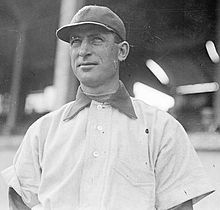
Fred Clarke, the winningest manager in Pirates history; he led the team to 1,422 victories along with a World Series title and four National League pennants.
The Pittsburgh Pirates are a Major League Baseball (MLB) franchise based in Pittsburgh, Pennsylvania. They play in the National League Central division. The team began play in 1882 as the Alleghenies (alternatively spelled "Alleghenys") in the American Association. The franchise moved to the National League after owner William Nimick became upset over a contract dispute, thus beginning the modern day franchise. The team currently plays home games at PNC Park which they moved into in 2001. Prior to PNC Park, the Pirates played games at Three Rivers Stadium and Forbes Field, among other stadiums.
There have been 46 managers for the Pittsburgh Pirates franchise. The Pirates' first manager upon joining the National League was Horace Phillips, who had coached the team before their move to the National League. In 1900, Fred Clarke began his tenure with the franchise. Clarke's 1422 victories and 969 losses lead all managers of the Pirates in their respective categories, Clarke also had the longest tenure as manager in his 16 years in the position. Clarke managed the franchise to its first World Series victory, a feat that would also be accomplished by Bill McKechnie, Danny Murtaugh, and Chuck Tanner. Thirteen Pirates managers have been player-managers—those who take on simultaneous roles as a player and manager. McKechnie, Connie Mack, and Ned Hanlon were inducted into the National Baseball Hall of Fame and Museum as managers. Five Pirates managers were inducted into the Hall of Fame for their performance as players. Billy Meyer's number 1, Pie Traynor's number 20, Honus Wagner's number 33, and Murtaugh's number 40 have been retired by the franchise. Hired before the 2020 season, the Pirates' current manager is Derek Shelton. (Full article...) -
Image 9

Giancarlo Stanton holds 10 records for the Marlins franchise, the most of any Marlins player.
The Miami Marlins are a Major League Baseball (MLB) franchise based in the U.S. state of Florida. The Marlins became members of MLB as an expansion team in the 1993 season. Through 2017, they have played 3,981 games, winning 1,870 and losing 2,111 for a winning percentage of .470. This list documents the superlative records and accomplishments of team members during their tenures as Marlins in MLB's National League East.
Giancarlo Stanton holds the most franchise records as of the end of the 2018 season, with ten records, including both the most career and single-season home runs, RBI, slugging percentage, and total bases records. (Full article...) -
Image 10

Roy Oswalt, the Houston Astros Opening Day starting pitcher for eight straight years, from 2003 through 2010.
The Houston Astros are a Major League Baseball (MLB) franchise based in Houston, Texas. They currently play in the American League West division. The first game of the new baseball season for a team is played on Opening Day, and being named the Opening Day starter is an honor, which is often given to the player who is expected to lead the pitching staff that season, though there are various strategic reasons why a team's best pitcher might not start on Opening Day.
The Astros began to play in 1962 as the Houston Colt .45s (their name was changed to the Astros in 1965 when the Houston Astrodome opened as their home ball park). Bobby Shantz started their first Opening Day game on April 10, 1962, against the Chicago Cubs at Houston's Colt Stadium and was credited with the win. In their first eight seasons, the Colt .45s / Astros used eight different Opening Day starters. In 1970, that streak ended when Larry Dierker made his second Opening Day start. (Full article...) -
Image 11
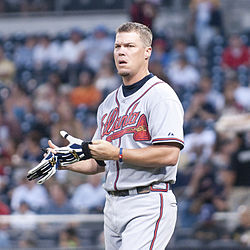
Chipper Jones won the National League MVP Award in 1999, four years after winning a World Series ring.
The Atlanta Braves are a Major League Baseball (MLB) franchise based in Atlanta, Georgia. They play in the National League East division. Officially known as the "First-Year Player Draft", the Rule 4 Draft is MLB's primary mechanism for assigning players from high schools, colleges, and other amateur clubs to its franchises. The draft order is determined based on the previous season's standings, with the team possessing the worst record receiving the first pick. In addition, teams which lost free agents in the previous off-season may be awarded compensatory or supplementary picks. Since the establishment of the draft in 1965, the Braves have selected 56 players in the first round.
Of those 56 players, 27 have been pitchers, the most of any position; 15 of these were right-handed, while 12 were left-handed. The Braves have also selected eight outfielders, seven shortstops, five catchers, four third basemen, three first basemen, and two second basemen in the initial round of the draft. The franchise has drafted nine players from colleges or high schools in the state of Florida, more than any other state. Eight more selections have come from their home state of Georgia. Two selections have come from outside the 50 United States: Luis Atilano (2003) is from the Commonwealth of Puerto Rico, and Scott Thorman (2000) is from Ontario, Canada. (Full article...) -
Image 12

Billy Conigliaro was the first player ever drafted by the Boston Red Sox, selected in the first round of the 1965 MLB draft. An outfielder, he played in MLB from 1969 through 1973.
The Boston Red Sox are a Major League Baseball (MLB) franchise based in Boston, Massachusetts. They play in the American League East division. This page lists prospects selected by the team in the first round of the annual Major League Baseball draft.
Officially known as the "First-Year Player Draft", the draft is MLB's primary mechanism for assigning amateur baseball players from high schools, colleges, and other amateur baseball clubs to its teams. The draft order is determined based on the previous season's standings, with the team possessing the worst record receiving the first pick. In addition, teams that lost free agents in the previous off-season may be awarded compensatory or supplementary picks. (Full article...) -
Image 13

The 1926 New York Yankees were one of 41 pennant-winning teams in the Yankees' history.
Every Major League Baseball (MLB) season, one American League (AL) team wins the pennant, signifying that they are the league's champion and have the right to play in the World Series against the champion of the National League (NL). The pennant was presented to the team with the best win–loss record each year through the 1968 season, after which the AL Championship Series (ALCS) was introduced to decide the pennant winner. The first modern World Series was played in 1903 and, after a hiatus in 1904, has taken place every season except 1994, when a players' strike forced the cancellation of the postseason. The current AL pennant holders are the New York Yankees, who beat the Cleveland Guardians for the pennant on October 19, 2024.
In 1969, the AL split into two divisions, and the teams with the best records in each division played one another in the five-game ALCS to determine the pennant winner, who received (and continues to receive) the William Harridge Trophy. The trophy featured a golden eagle, the league's emblem, sitting atop a silver baseball and clutching the AL banner. Since 2017, the trophy is all silver with a pennant on top. The trophy is named for Will Harridge, who was league president from 1931 to 1958. The format of the ALCS was changed from a best-of-five to a best-of-seven format in the 1985 postseason. In 1995, an additional playoff series was added when MLB restructured into three divisions in each league. As of 2022[update], the winners of the Eastern, Central, and Western Divisions, as well as the three AL Wild Card winners, play in the AL Division Series, a best-of-five playoff to determine the opponents who will play in the ALCS. AL pennant winners have gone on to win the World Series 68 times, most recently in 2023. (Full article...) -
Image 14
The Edgar Martínez Outstanding Designated Hitter Award, commonly referred to as the Edgar Martínez Award and originally known as the Outstanding Designated Hitter Award, has been presented annually to the most outstanding designated hitter (DH) in Major League Baseball (MLB) since 1973. The award is voted on by club beat reporters, broadcasters, and public relations departments. The Associated Press discontinued the award in 2000, but it was picked up by the Baseball Writers' Association of America, which has administered it since. All players with a minimum of 100 at bats at DH are eligible. From the award's inception in 1973 until 2019, and in 2021, use of the designated hitter was allowed only in the American League (AL).
In September 2004, at Safeco Field (now T-Mobile Park) ceremonies in honor of Edgar Martínez, Commissioner Bud Selig announced that the award would be renamed for the five-time recipient (1995, 1997–98, 2000–01). In an 18-year career with the Seattle Mariners, primarily as a designated hitter, Martínez batted .312, with 309 career home runs and 1,261 runs batted in. (Full article...) -
Image 15
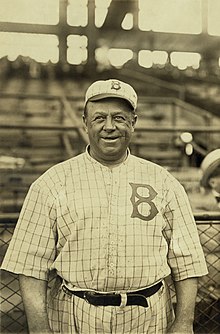
In baseball, a hit is credited to a batter when he reaches first base – or any subsequent base – safely after hitting a fair ball, without the benefit of an error or a fielder's choice. One hundred nineteen different players have recorded at least six hits in a single nine-inning Major League Baseball game. Five players have accomplished the feat more than once in their career; no player has ever recorded more than seven hits in a nine-inning game. Davy Force was the first player to collect six hits in a single game, doing so for the Philadelphia Athletics against the Chicago White Stockings on June 27, 1876.
These games have resulted in other single-game MLB records being set in connection with the prodigious offensive performance. Shawn Green, for example, established a new major league record with 19 total bases and finished with a total of five extra-base hits, tying a National League record that was also achieved by Larry Twitchell during the latter's six-hit game. Four of Green's six hits were home runs, equaling the record for most home runs in one game. Jim Bottomley, Walker Cooper, Anthony Rendon, and Wilbert Robinson hit 10 or more runs batted in (RBI) to complement their six hits. Robinson proceeded to collect a seventh hit and an eleventh RBI to set single-game records in both categories. Although his record of 11 RBIs has since been broken, Robinson's seven hits in a nine-inning game has been matched only by Rennie Stennett. (Full article...)
More did you know
- ... that Dock Ellis pitched a no-hitter while under the influence of LSD?
- ... that Lorinda de Roulet is the first woman to direct the day-to-day operations of a Major League Baseball franchise?
- ... that Max Kepler-Rozycki received the largest signing bonus given to a European player by a Major League Baseball team?
- ... that Andrew Heaney led all college baseball pitchers in strikeouts during the 2012 season?
- ... that Johnny Evers alerted an umpire to Merkle's Boner?
Sports portals
Selected picture

| Credit: Keith Allison |
Chien-Ming Wang (Chinese: 王建民; pinyin: Wáng Jiànmín; Wade–Giles: Wang Chien-min; born March 31, 1980) is a Taiwanese starting pitcher for the Washington Nationals in Major League Baseball. He was initially signed as an amateur free agent by the New York Yankees prior to the 2000 season. He came to be known as the Yankees ace pitcher over the 2006 and 2007 seasons.
Associated Wikimedia
The following Wikimedia Foundation sister projects provide more on this subject:
-
Commons
Free media repository -
Wikibooks
Free textbooks and manuals -
Wikidata
Free knowledge base -
Wikinews
Free-content news -
Wikiquote
Collection of quotations -
Wikisource
Free-content library -
Wikiversity
Free learning tools -
Wiktionary
Dictionary and thesaurus
More portals
- Portals with triaged subpages from June 2018
- All portals with triaged subpages
- Portals with no named maintainer
- Automated article-slideshow portals with 51–100 articles in article list
- Automated article-slideshow portals with 501–1000 articles in article list
- Random portal component with 41–50 available subpages
- Automated article-slideshow portals with 201–500 articles in article list
- Random portal component with 11–15 available subpages
- Random portal component with 21–25 available image subpages



